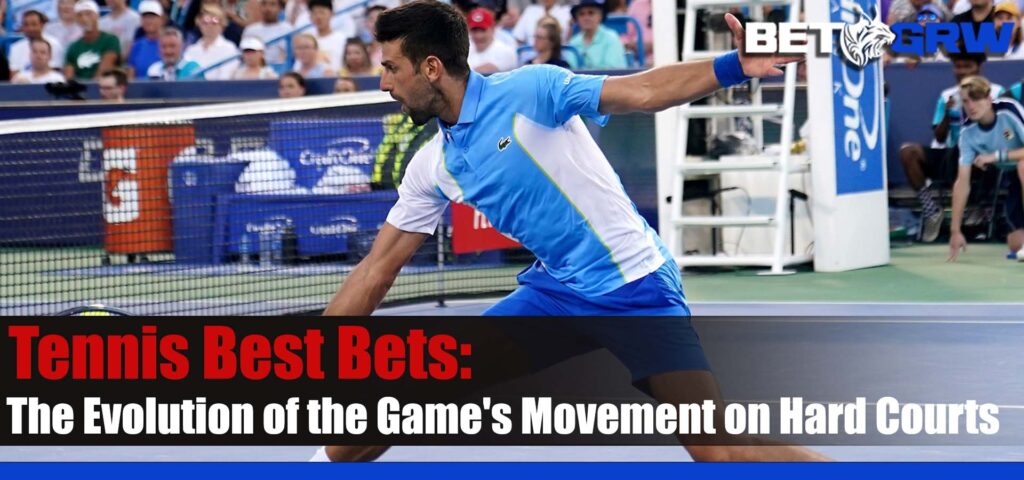
The Evolution of the Game’s Movement on Hard Courts – Modern tennis has witnessed significant evolution over time, as players continually break from conventional thinking to redefine conventional beliefs and push beyond what was once considered acceptable boundaries. One significant development that has had an indelible mark on its growth has been the rise in importance of sliding on hard courts – once thought only reserved for clay surfaces – today’s top players have taken to using hard courts as an arena for tennis picks, sliding with greater ease than before. Not only has this revolutionized playing styles and tactics, but it has also redefined the strategic and technical approaches used during play.
The Alcaraz-Djokovic Showdown: A Defining Moment in Sliding History
Sliding’s significance in modern tennis was displayed during Carlos Alcaraz and Novak Djokovic’s intense match in Cincinnati. Amid stunning shotmaking, their court coverage stood out as being instrumental. Their smooth gliding feet on hard courts were genuinely mesmerising, allowing them to reach seemingly inaccessible balls while pivoting with exceptional efficiency – an indication of its massive significance as players now incorporate sliding as part of their repertoire even on hard courts. This marked an unprecedented shift in sports dynamics; players now incorporate sliding as part of their arsenal, even on hard courts.
The Evolution of the Game’s Movement on Hard Courts: The Crucial Role of Sliding in Modern Tennis
Tennis has developed into a game with thin margins, often decided by just a handful of critical points. Modern player athleticism combined with slower hard courts has increased the emphasis on movement; sliding from clay specialists has become part of mainstream tennis – this change likely playing an influential role in crowning champions of events like the US Open.
From Clay to Hard: The Natural Evolution of Sliding
The shift from sliding being solely a clay-court strategy to becoming prevalent on hard courts is a testament to the sport’s adaptability. Although sliding on hard courts isn’t a recent innovation, it has gained prominence recently. Michael Chang, Marcelo Rios, and Paradorn Srichaphan laid the groundwork for the modern era’s hard-court sliders. Notably, Kim Clijsters demonstrated the effectiveness of sliding into shots on the women’s tour. Today, the torchbearers of this evolution are none other than the current World No. 1s, Carlos Alcaraz and Iga Swiatek, who have seamlessly incorporated sliding into their playing styles.
An Unconscious Mastery: The Birth of Hard-Court Sliding
Interestingly, the art of sliding on hard courts was not a skill deliberately acquired by players. Alcaraz, Swiatek, and their contemporaries recall it as a natural progression. This indicates a generational influence where players grew up watching sliding in tennis and subconsciously incorporated it into their games. The lack of formal training in sliding further underscores its intuitive adoption among players.
Sliding Techniques: Masters of the Slide
Not all slides are created equal, and there are varying degrees of mastery. Some players opt to slide on one foot, often their dominant one, while others utilize the court’s friction to adjust their direction post-shot. The most proficient sliders can slide off both feet and seamlessly integrate sliding into open-stance shots. This adaptation is evident in rising stars like Alcaraz and Sinner, who exploit this technique for additional time and positioning advantages during rallies.
The Novak Djokovic Factor: Setting the Gold Standard
Novak Djokovic remains unrivaled as an icon of tennis. He continues to showcase unmatched mastery through his flexibility, balance, speed, and ability to slide off both legs effortlessly, further solidifying his dominance through adapting this form of sliding across various surfaces (grass included) without losing his edge in professional tennis competition.
Balancing Act: The Dangers of Sliding on Hard Courts
Sliding on hard courts has transformed the sport, yet it has some inherent risks. Sliding can take an immense physical toll on an athlete’s body – particularly their ankles – exerting up to three times their body weight on each ankle as the force generated by each slide exerts force three times higher than what might otherwise occur during play. Before sliding into their game, athletes should assess their bodies’ readiness.
The Future of Tennis: A Glide Toward Innovation
Tennis has long been defined by its constant development, and sliding’s expansion onto hard courts – including betting sites in Canada – is a testament to this change. As tennis evolves, sliding will remain a central aspect of modern hard-court play. Alcaraz and Swiatek are at the forefront of this transformation, with Djokovic setting an exemplary example. ultimately, this gliding evolution on hard courts will sculpt its future for years. This is a testament to how successfully tennis adapts and adopts new techniques, ultimately enhancing players and fans.










